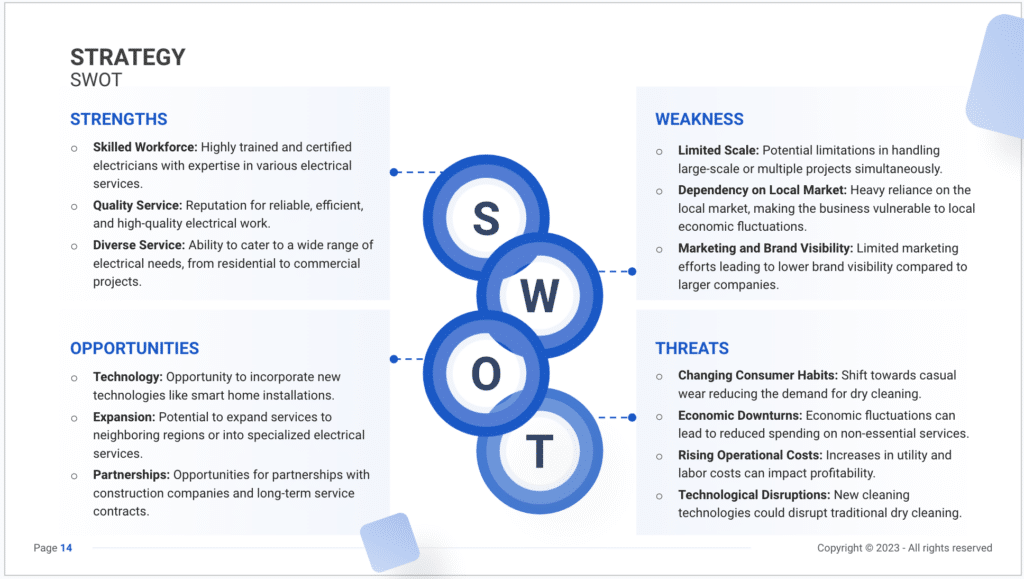SWOT Analysis for an Electrical Contractor (Example)

A SWOT analysis is part of any business plan. SWOT (Strengths, Weaknesses, Opportunities, and Threats) acts as a guiding framework, assisting contractors in evaluating internal strengths and weaknesses, as well as external opportunities and threats.
While strengths and weaknesses are elements within the contractor’s control, opportunities and threats are external factors that can significantly impact the business.
Examples of strengths may include a skilled technical workforce, the adoption of cutting-edge technology, and the establishment of strategic industry partnerships. Conversely, weaknesses could encompass limitations in geographical reach or a dependency on a specific supplier.
This article will explore various illustrations of strengths and weaknesses, offering guidance to electrical contractors on effectively integrating them into their business plans.

Strengths
Electricians possess inherent strengths that position them as essential service providers in the electrical services industry.
- Technical Expertise and Certification: Electricians boast specialized knowledge and certifications, ensuring they are equipped to handle diverse electrical projects.
- Example: Displaying certifications prominently on marketing materials and emphasizing continuous training builds trust with clients.
- Versatility in Services: The ability to offer a broad range of services, from routine electrical maintenance to complex installations, showcases versatility.
- Example: Marketing services for both residential and commercial sectors caters to a wider client base, increasing revenue opportunities.
- Emergency Response Capability: Electricians often offer emergency services, providing timely solutions to electrical issues, and establishing a reputation for reliability.
- Example: Implementing a 24/7 emergency hotline and showcasing swift response times in promotional materials reinforces the brand’s commitment to customer service.
- Compliance with Safety Standards: Adherence to strict safety standards ensures the safety of clients and their properties, instilling confidence in the electrician’s services.
- Example: Incorporating safety demonstrations in marketing content and offering complimentary safety inspections create added value for clients.
Weaknesses
Identifying weaknesses is crucial for electricians to enhance service quality and address potential challenges.
- Dependency on External Factors: Electricians may face challenges related to external factors such as weather conditions, affecting outdoor projects.
- Example: Diversifying service offerings to include indoor projects during adverse weather conditions mitigates the impact of weather-related challenges.
- Limited Geographic Reach: A limited service area may restrict the client base and revenue potential for electricians.
- Example: Expanding marketing efforts to neighboring regions and forming partnerships with local businesses can broaden the geographic reach.
- Reliance on Specialized Tools: Electricians heavily rely on specialized tools, and equipment malfunctions can lead to project delays.
- Example: Regular maintenance of tools, investing in high-quality equipment, and having backup tools on hand minimize the risk of delays.
- Seasonal Fluctuations in Demand: Demand for electrical services may fluctuate seasonally, impacting the consistency of projects throughout the year.
- Example: Offering seasonal promotions, such as discounted safety inspections before extreme weather seasons, can help maintain a steady workflow.
Opportunities
Identifying and capitalizing on opportunities is essential for electricians aiming for growth and adaptability in a competitive market.
- Renewable Energy Installations: The growing interest in renewable energy presents an opportunity for electricians to specialize in solar panel installations and other sustainable solutions.
- Example: Obtaining certifications in renewable energy installations and incorporating eco-friendly practices in promotional materials attract environmentally conscious clients.
- Smart Home Technology Integration: The rise of smart home technology creates opportunities for electricians to offer installation and integration services.
- Example: Marketing expertise in smart home technology and collaborating with technology retailers enhance the electrician’s appeal in a tech-savvy market.
- Energy Efficiency Consultations: Providing energy efficiency consultations positions electricians as advisors, helping clients reduce energy consumption.
- Example: Offering complimentary energy audits and promoting energy-efficient solutions demonstrate a commitment to sustainable practices.
- Collaboration with Home Improvement Services: Partnering with home improvement services opens avenues for bundled services, catering to clients looking for comprehensive solutions.
- Example: Establishing partnerships with home renovation contractors and jointly marketing bundled services streamlines customer acquisition.
Threats
Anticipating and mitigating threats is crucial for electricians to ensure resilience and sustainability in a dynamic market.
- Competition from Unlicensed Providers: Unlicensed providers may offer lower-cost services, posing a threat to licensed electricians.
- Example: Emphasizing the importance of licensing in marketing materials and offering value-added services, such as warranties, differentiates the electrician from unlicensed competitors.
- Economic Downturns: Economic downturns can lead to reduced spending on home improvement projects, impacting the demand for electrical services.
- Example: Implementing flexible payment plans and offering promotional discounts during economic downturns can help maintain customer loyalty.
- Technological Disruptions: Rapid technological advancements may require electricians to continuously update skills and tools to remain competitive.
- Example: Investing in ongoing training programs and staying informed about emerging technologies ensure the electrician stays ahead in a tech-driven market.
- Regulatory Changes and Compliance Challenges: Evolving regulations in the electrical industry may pose compliance challenges, requiring electricians to adapt quickly.
- Example: Regularly updating operational procedures to comply with changing regulations and actively participating in industry associations can ensure the electrician remains compliant.





